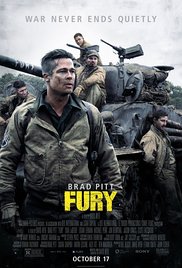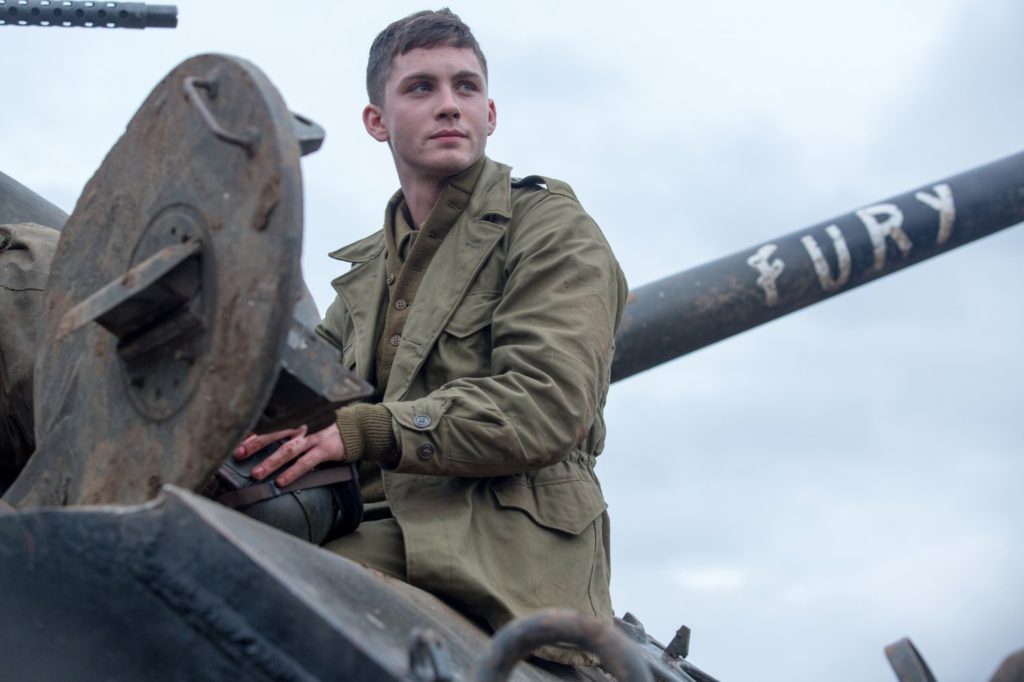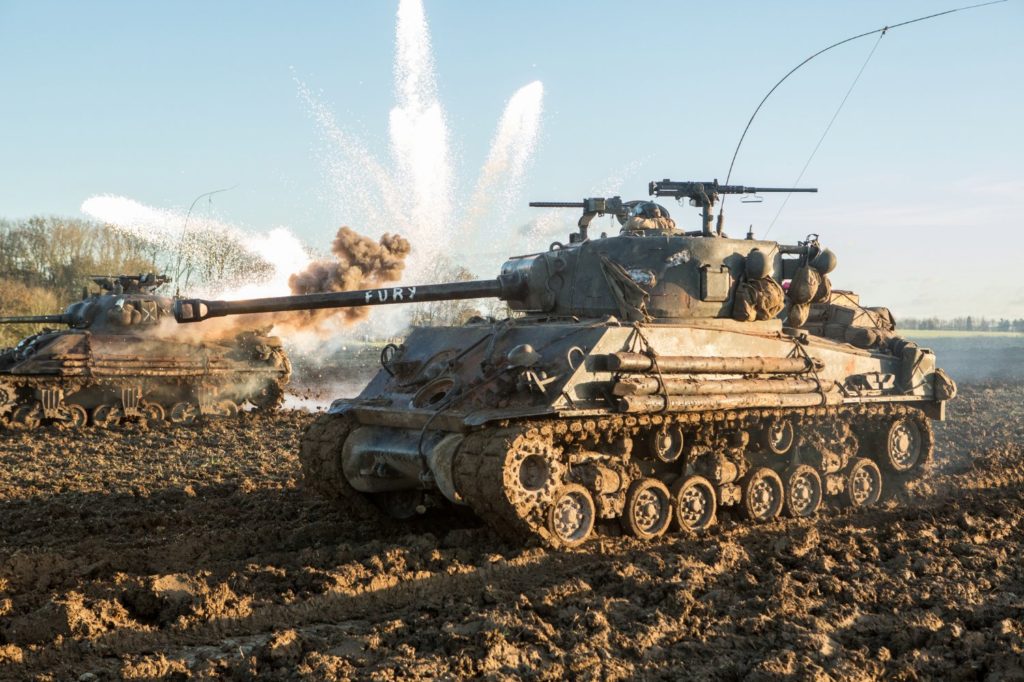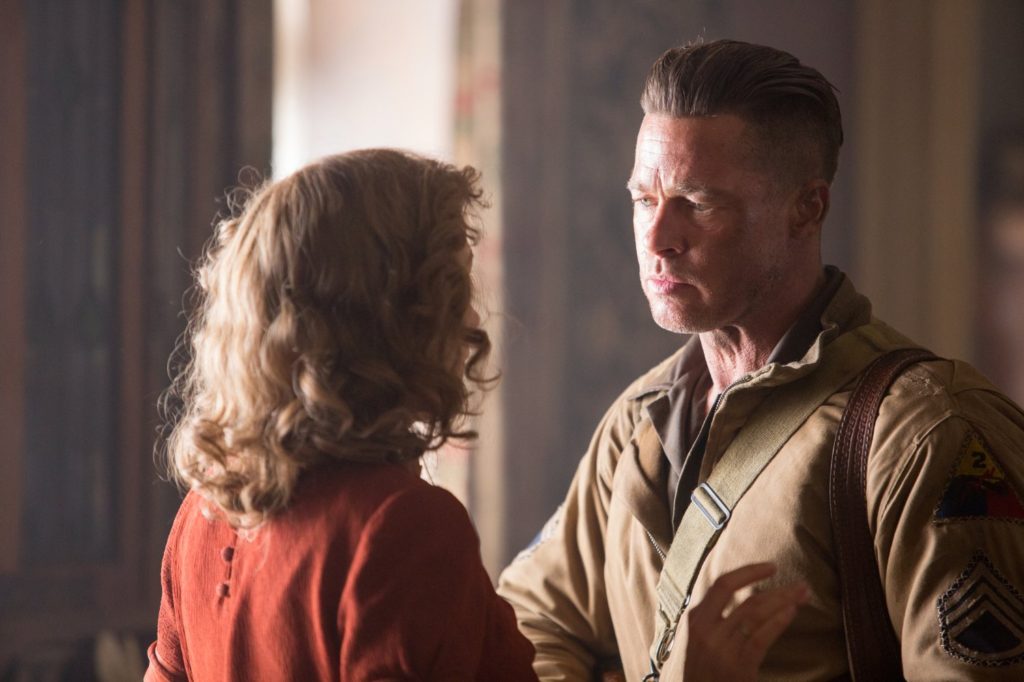It’s World War 2 All Over Again For Brad Pitt
DIRECTED BY DAVID AYER/2014
 “Why are you showing me this?”
“Why are you showing me this?”
“Ideals are peaceful. History is violent”.
Perhaps you’ve heard that exchange in the trailer for the film its from, Fury. I honestly don’t know whether it’s there or not. But the fact is that in the waning years of World War II, despite however “screenwriterly” that answer may sound, few would dispute it. The year is 1945, and although the war would soon be over, for this handful of men, it has become a way of life. Once, like the new gunner they would acquire from a desk job, they too were fresh-faced and had never taken a life. But that was a long time ago. Far before this story begins. And anyone who’s seen more than a handful of war films has seen it all before. Yet, it resonates.
It is precisely the uncomfortable but volatile space in-between the extremes of the overly familiar war film cliches (many dating back to the war itself) and the filmmakers’ obvious desire to “show truth”, to unflinchingly “tell it like it was”, that Fury operates – and ultimately succeeds.
Fury doesn’t reinvent the wheel, even as it does physically lose a few along the way. (Landmines, enemy weaponry, etc.) Through its depiction of a tight-knit unit (established as such in the film’s opening – and clunkiest – scenes) together in a Tiger I tank – the men, in true war movie fashion, a melting pot micro-chasm of different ethnic backgrounds and religious beliefs – come to show us the sheer brutality, the insanity, the heroics and the ethical problems that happened in the defeat of the Nazis.

Logan Lerman in FURY.
Logan Lerman (The Perks of Being a Wallflower) plays Norman, the daunted audience surrogate thrust into the worldof warand killing with extreme prejudice. Although his arc is predictable, the talented Lerman makes it work. Like Norman, he proves to be the right man for the job.
Leading man Brad Pitt, for all intents and purposes, revives Aldo from Inglourious Basterds.Although here he’s granted far more screen time, making Fury a more traditional star vehicle – meaning, unlike his previous foray into WWII,he’s unable to disappear out of the movie for an hour of screen time. Here, he’s tank commander Collier – a man harboring as much bloodlust as honor. In many moments a heartless terror, in others the first you’d want in your corner, Collier through Norman’s eyes earns all the cumulative resentment then respect that one like him would be expected to rack up. But it’s an organic thing, as organic as the fourteen inches of black mud peeling off the churning treads as they roll through what’s left of Germany. Pitt may be a big movie star, but it’s telling that his star vehicle of choice is a battle-worn tank.
One thing Fury does very well in its first half is demonstrate how in war ones inability to become a remorseless killing machine can in fact be a liability. Eventually, we come to see the cost of war on the souls of men – but it’s a long time coming. Fury is one of those films that will not, absolutely WILL NOT, let us forget that war is hell. But amid its R-rated grit, its blood and bodies, its washed-out desolation so trenchant to today’s filmgoers, there lies at the calloused heart of it all a straight-ahead war movie that could be a future favorite of aged dads everywhere. (Look for Fury in future Father’s Day DVD retail endcaps.)

Tiger, tiger burning bright…
Shia LaBeouf is on hand as Boyd “Bible” Swan, a born-again soldier, a follower of Christ, who, like everyone else, has long since understandably lost his bearings. Perhaps once time long ago he too was like Logan Lerman’s Norman – a wide-eyed newbie thrown to the wolves of war. At least that’s how the mustached and grimy LaBeouf plays him in the supporting role he occupies. (Don’t let his second-billing fool you. This is The Pitt and Lerman Show.) One gets the impression that the part of Swan was of varying size and importance through different aspects of the development of Fury. In most cases, less LaBeouf is never a bad thing, although a deeper look at the heavily sidelined “Bible” Swan – dealing specifically with how a Christian of that era manages as a soldier in wartime – would’ve been appreciated.
In certain ways Fury mildly subverts the war genre, and in other ways it absolutely runs with it. The inclusion of Norman is a way that it runs with it. It’s tempting to wonder what the movie would be like without him. It may in fact be a better, more brazen, and bolder film. With him, there’s a more traditional bent, even as the carnage and the cinematography and the violence (all very commercial) are more palatable, more relatable today’s audiences.

Brad Pitt in FURY.
But as much as I wish it weren’t so, Fury seems to be more honest and more true about the wartime experience. The “hokey old war movies” of yesteryear served a great purpose, and certain propaganda in wartime was not without merit. But this is not that. Fury is one of those stories that wants to tell us “how it really was”, although most of us today cannot know that first hand. But for its two hours and fourteen minute running time, Fury puts us right in that tank, right in that experience on that battlefield as well as anything could. Inside the tank, the shots are all repetitively tight. And there are a lot of them. This is something that at first felt like a cinematic shortcoming, but eventually bore out as a lingering reminder of the tight confines and limited vantage point of life from within such an armored behemoth. Unlike Quentin Tarantino’s high-flying Inglourious Basterds,this film doesn’t go out of its way to tell us something that is made up to fulfill some very real lingering need for catharsis – even if this was an original screenplay by director David Ayer. (Ayer being a relatively new director with the jury still out: he made impressive found footage cop movie End of Watch, but also the widely reviled Schwarzenegger vehicle Sabotage.)
So why is writer/director Ayer showing us this? Because history is violent, yes. But ideals are what is fought for, even as they are just what so many soldiers had to give up in order to serve their countries so long ago in the vitally important second world war. This tension is not avoidable, nor is it avoided in Fury. The message doesn’t come at you like a Sherman tank, but it does put you inside a Tiger tank called Fury. And may the war end there.


